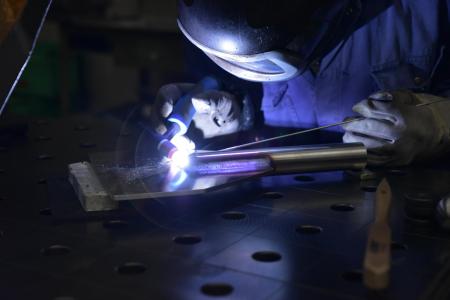In this article the following will be discussed:
- The criteria that a weld ideally should meet
- Purification equipment and techniques
- The final quality of a weld
The experts at Dinnissen Process Technology are available to answer all your questions:
Get in touch with Juul Jenneskens 077 467 3555
The criteria that a weld ideally should meet
Companies that process food are expected to do so in a safe and hygienic manner. Hygiene depends on a number of factors, including the quality of the surfaces that come into contact with the product. This article is specifically about substances that come into contact with welded surfaces. These welding surfaces in stainless steel pipes are often the parts that wear out first and can compromise hygiene. Ideally, in order to delay that wear as long as possible, the welded parts should meet all of the following points:
- A complete penetration,
- without cracks or porosity,
- no burn-throughs,
- good amalgamation,
- good alignment,
- no internal discoloration,
- no cavity,
- no bulb formation,
- no inclusions,
- no increased surface roughness,
- no major imperfections,
- no associated metallurgical changes,
- no arc strikes.
Unfortunately, it is virtually impossible in practice to make a weld meet all of the above characteristics. This does not mean that a weld without these characteristics is suitable for the food industry. After all, it must always be hygienically acceptable. However, there is a way to achieve as many desired characteristics as possible. This can be done by checking all process steps within the entire welding process. That is also the reason why automatic welding is often preferred instead of manual welding. With automatic welding, repeatability and consistency can be guaranteed, which leads to better control of the welding process.
An automatic weld provides more guarantees of reproducibility and consistency. Yet the welding operator is also responsible for many factors that affect the quality of a mechanical weld. It is therefore crucial that the welding operator has been properly trained and works with the correct SOPs (Standard Operating Procedures) in a hygienic environment. This in combination with high-quality equipment ensures the highest chance of a high-quality weld.

Food-grade welding of piping

Food-grade welding
Purification equipment and purification techniques
A clean and corrosion-free internal weld can only be obtained with a low oxygen content. Figure 1 shows the influence of different oxygen levels in pure argon gas on the discoloration of the weld. Discoloration is not desirable. Good purification technology and suitable purification equipment are therefore necessary to weld as hygienically as possible. In addition, internal purification is mandatory at all stages.
To ensure adequate gas coverage, the purification equipment must be properly sealed. This ensures that no oxygen can enter the piping system. Both silicone and rubber plugs can be used for short pipe sections. Both are cheap and easy to use. Gas chambers are more suitable for longer connections. These are advantageous because only a small part of the tube needs to be filled with gas. In addition to plugs and gas chambers, dissolvable closures are also suitable. These soluble seals wash away easily without the risk of damage. Internal damage to the hose should always be avoided as much as possible. Internal damage can be caused by incorrect choice of materials or purification equipment. No internal purification, just like insufficient gas coverage, results in discoloration or charring. The corrosion resistance is then no longer sufficient, so that the weld is insufficiently hygienic.
The quality of a finished weld
Only when the gap of the weld is controlled and consistent can penetration and an even bead of weld be achieved. Good preparation is crucial in this regard. A good quality weld can be made quite easily with the help of mechanised tools that aid in preparation. Examples include cutting the pipe exactly straight or chamfering the pipe as shown in Figures 2 and 3. This tool can help create flat square or flattened pipe ends without creating roughness or warping. The conditions are that the tool is used correctly and that it is made of materials that match the pipe material that is being welded.
The final quality of a weld can be assessed by direct or indirect visual inspections. Examples of indirect visual inspections are endoscopy or X-rays. Endoscopy can be used for an internal visual inspection. In addition, it is important that one is careful not to damage internal surface. Should damage nevertheless occur, it can possibly be solved by staining or passivating the surface.
With automatic welding, repeatability and consistency can be guaranteed, which leads to better control of the welding process

Name: Juul Jenneskens
Advisor
Please feel free to contact me if you have any questions about this subject. My team of colleagues and I are ready to answer!
Get in touch with Juul Jenneskens 077 467 3555 [email protected]
Do you prefer to request a consultation directly?
